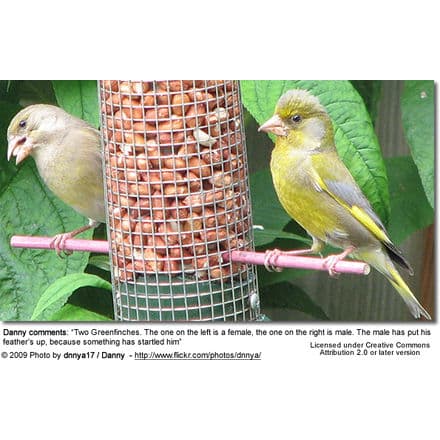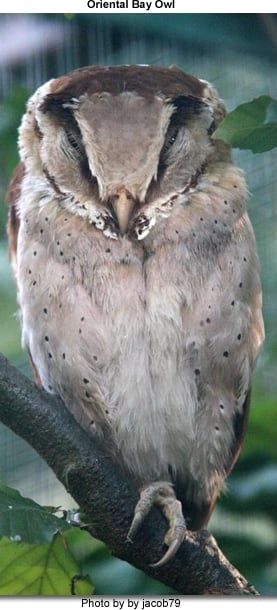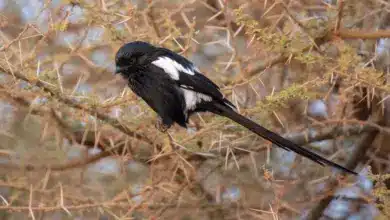European Greenfinches or Greenfinches as Aviary Birds
Breeding European Greenfinches diet must include a mixture of millets, canary grass seeds, wild seeds, and green food. These birds are especially fond of Safflower, and Thistle.
Greenfinches (Origin, Natural Habitat and Behavior)
Finch Information … Index of Finch Species … Photos of the Different Finch Species for Identification
Finch Data: Range, Length, Clutch-size and Incubation Periods for each Finch Species
The Greenfinch in Aviculture:
The below information is courtesy of Mandy and Paul – Breeder of Canaries and Other Exotic Birds – Singing Wings Aviary – www.singing-wings-aviary.com (A great source for these beautiful little finches)
Mutations/Sub-species:
Several color mutations are now established including Lutino, Cinnamon, and Isabel.
Diet:
A good Greenfinch diet must include a mixture of millets, canary grass seeds, wild seeds, and green food. These birds are especially fond of Safflower, and Thistle. They will require more green food when breeding. While they are not as insectivorous as some birds they do enjoy live food. Ant eggs, small mealworms, waxworms, and fruit fly larvae can be mixed in with soft food and offered on occasion. Fresh water, cuttlebone and grit should also be supplied at all times. Lettuce, Spinach, Chickweed, spray millet, Eggfood, Brocolli tops, and Carrot tops can also be offered on a regular basis.
Sprouted or germinated seeds are usually more easily accepted by “seed addicts” than fresh fruits and vegetables.
- Sprouted seeds are healthier as the sprouting changes and enhances the nutritional quality and value of seeds and grains. Sprouted seeds are lower in fat, as the process of sprouting utilizes the fat in the seed to start the growing process – thus reducing the fat stored in the seeds.
- Sprouted seeds will help balance your bird’s diet by adding a nutritious supply of high in vegetable proteins, vitamins, minerals, enzymes, and chlorophyll.
- Soaked and germinated “oil” seeds, like niger and rape seeds, are rich in protein and carbohydrates; while “starch” seeds, such as canary and millets, are rich in carbohydrates, but lower in protein.
- It is an invaluable food at all times; however, it is especially important for breeding or molting birds. Sprouted seeds also serve as a great rearing and weaning food as the softened shell is easier to break by chicks and gets them used to the texture of seeds.
General Care:
Generaly hardy and easy to care for this species loves to bath and needs fresh bath water daily.
Compatibility:
European Greenfinches can be kept in a mixed aviary with birds of similar size or in individual pairs.
Housing:
Many European Greenfinches are house in individual breeding cages much like Canaries. However, they will thrive in a large planted aviary with plenty of room to fly and sing.
Breeding:
Establish European Greenfinches pairs can be very free breeders. They will breed in a good size cage or flight normally from October to January. They prefer a Canary type nest positioned in a high sheltered spot such as the corner of a cage. Artifical plant covering around the nest will provide them with the nest privacy they need.
Nesting material supplied can be dried moss, feathers, or soft Canary nesting material. The average clutch consist of 4-6 eggs which hatch after 14-17 days. The hen incubates the eggs alone for the most part while the male guards the nest. After the eggs hatch it is important to supply the parents with adequate Teasel, greenfood, eggfood and livefood. Sprouted or germinated seeds are usually eagerly accepted during the breeding season. Sprouted seeds also serve as a great rearing and weaning food as the softened shell is easier to break by chicks and gets them used to the texture of seeds.
The young, brown streaked Greenfinches will fledge around 2 weeks old. The male then assumes feeding responsibilities until the young are weaned.
Other Resources:
- Common Health Problems of Finches
- Finch / Canary Diet / Nutrition
- Finch Data: Range, Length, Clutch-size and Incubation Periods for each Finch Species
Please Note: The articles or images on this page are the sole property of the authors or photographers. Please contact them directly with respect to any copyright or licensing questions. Thank you.






